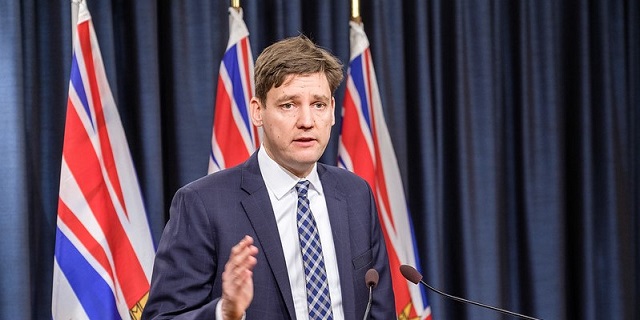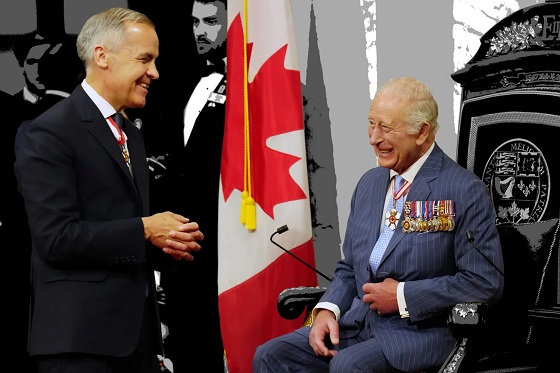Fraser Institute
Yes, B.C.’s Land Act changes give First Nations veto over use of Crown Land

From the Fraser Institute
By Bruce Pardy
Nathan Cullen says there’s no veto. Cullen, British Columbia’s Minister of Water, Land, and Resource Stewardship, plans to give First Nations joint decision-making authority over Crown land. His NDP government recently opened consultations on its proposal to amend the B.C. Land Act, under which the minister grants leases, licences, permits, rights-of-way and land sales. The amendments will give legal effect to agreements with Indigenous governing bodies. Those agreements will share decision-making power “through joint or consent models” with some or all of B.C.’s more than 200 First Nations.
Yes, First Nations will have a veto.
Cullen denies it. “There is no veto in these amendments,” he told the Nanaimo News Bulletin last week. He accused critics of fearmongering and misinformation. “My worry is that for some of the political actors here on the right, this is an element of dog-whistle politics.”
But Cullen has a problem. Any activity that requires your consent is an activity over which you have a veto. If a contract requires approval of both parties before something can happen, “no” by one means “no” for both. The same is true in other areas of law such as sexual conduct, which requires consent. If you withhold your consent, you have vetoed the activity. “Joint decision-making,” “consent,” and “veto” come out to the same thing.
Land use decisions are subject to the same logic. The B.C. government will give First Nations joint decision-making power, when and where agreements are entered into. Its own consultation materials say so. This issue has blown up in the media, and the government has hastily amended its consultation webpage to soothe discontent (“The proposed amendments to the Land Act will not lead to broad, sweeping, or automatic changes (or) provide a ‘veto.’”) Nothing to see here folks. But its documentation continues to describe “shared decision-making through joint or consent models.”
These proposals should not surprise anyone. In 2019, the B.C. legislature passed Bill 41, the Declaration of the Rights of Indigenous Peoples Act (DRIPA). It requires the government to take “all measures necessary” to make the laws of British Columbia consistent with the United Nations Declaration on the Rights of Indigenous People (UNDRIP).
UNDRIP is a declaration of the U.N. General Assembly passed in 2007. It says that Indigenous people have “the right to the lands, territories and resources which they have traditionally owned, occupied or otherwise used or acquired… to own, use, develop and control.”
On its own, UNDRIP is non-binding and unenforceable. But DRIPA seeks to incorporate UNDRIP into B.C. law, obligating the government to achieve its aspirations. Mere consultation with First Nations, which Section 35 of the Constitution requires, won’t cut it under UNDRIP. Under Section 7 of DRIPA, agreements to be made with indigenous groups are to establish joint decision-making or to require consent of the Indigenous group. Either Cullen creates a First Nations veto or falls short of the goalposts in DRIPA. He is talking out of both sides of his mouth.
Some commentators warned against these dangers long ago. For example, shortly after DRIPA was passed in 2019, Vancouver lawyer Robin Junger wrote in the Vancouver Sun, “It will likely be impossible for government to live up to the expectations that Indigenous groups will now reasonably hold, without fundamentally affecting the rights and interests of third parties.” Unfortunately, few wanted to tackle that thorny question head on at the time. All three political parties in B.C. voted in favour of DRIPA, which passed unanimously.
For a taste of how Land Act changes could work, ask some B.C. residents who have private docks. In Pender Harbour, for instance, the shishalh Nation and the province have jointly developed a “Dock Management Plan” to try and impose various new and onerous rules on private property owners (including red “no go” zones and rules that will make many existing docks and boat houses non-compliant). Property owners with long-standing docks in full legal compliance will have no right to negotiate, to be consulted, or to be grandfathered. Land Act amendments may hardwire this plan into B.C. law.
Yet Cullen insists that no veto will exist since aggrieved parties can apply to a court for judicial review. “[An agreement] holds both parties—B.C. and whichever nation we enter into an agreement (with)—to the same standard of judicial review, administrative fairness, all the things that courts protect when someone is going through an application or a tendering process,” he told Business in Vancouver.
This is nonsense on stilts. By that standard, no government official has final authority under any statute. All statutory decisions are potentially subject to judicial review, including decisions of Cullen himself as the minister responsible for the Land Act. He doesn’t have a veto? Of course he does. Moreover, courts on judicial review generally defer to statutory decision-makers. And they don’t change decisions but merely send them back to be made again. The argument that First Nations won’t have a veto because their decisions can be challenged on judicial review is legal jibber jabber.
When the U.N. passed UNDRIP in 2007, people said they can’t be serious. When the B.C. legislature passed DRIPA in 2019, people said they can’t be serious. The B.C. government now proposes to give First Nations a veto over the use of Crown land. Don’t worry, they can’t be serious.
Author:
Alberta
Alberta Next Panel calls for less Ottawa—and it could pay off

From the Fraser Institute
By Tegan Hill
Last Friday, less than a week before Christmas, the Smith government quietly released the final report from its Alberta Next Panel, which assessed Alberta’s role in Canada. Among other things, the panel recommends that the federal government transfer some of its tax revenue to provincial governments so they can assume more control over the delivery of provincial services. Based on Canada’s experience in the 1990s, this plan could deliver real benefits for Albertans and all Canadians.
Federations such as Canada typically work best when governments stick to their constitutional lanes. Indeed, one of the benefits of being a federalist country is that different levels of government assume responsibility for programs they’re best suited to deliver. For example, it’s logical that the federal government handle national defence, while provincial governments are typically best positioned to understand and address the unique health-care and education needs of their citizens.
But there’s currently a mismatch between the share of taxes the provinces collect and the cost of delivering provincial responsibilities (e.g. health care, education, childcare, and social services). As such, Ottawa uses transfers—including the Canada Health Transfer (CHT)—to financially support the provinces in their areas of responsibility. But these funds come with conditions.
Consider health care. To receive CHT payments from Ottawa, provinces must abide by the Canada Health Act, which effectively prevents the provinces from experimenting with new ways of delivering and financing health care—including policies that are successful in other universal health-care countries. Given Canada’s health-care system is one of the developed world’s most expensive universal systems, yet Canadians face some of the longest wait times for physicians and worst access to medical technology (e.g. MRIs) and hospital beds, these restrictions limit badly needed innovation and hurt patients.
To give the provinces more flexibility, the Alberta Next Panel suggests the federal government shift tax points (and transfer GST) to the provinces to better align provincial revenues with provincial responsibilities while eliminating “strings” attached to such federal transfers. In other words, Ottawa would transfer a portion of its tax revenues from the federal income tax and federal sales tax to the provincial government so they have funds to experiment with what works best for their citizens, without conditions on how that money can be used.
According to the Alberta Next Panel poll, at least in Alberta, a majority of citizens support this type of provincial autonomy in delivering provincial programs—and again, it’s paid off before.
In the 1990s, amid a fiscal crisis (greater in scale, but not dissimilar to the one Ottawa faces today), the federal government reduced welfare and social assistance transfers to the provinces while simultaneously removing most of the “strings” attached to these dollars. These reforms allowed the provinces to introduce work incentives, for example, which would have previously triggered a reduction in federal transfers. The change to federal transfers sparked a wave of reforms as the provinces experimented with new ways to improve their welfare programs, and ultimately led to significant innovation that reduced welfare dependency from a high of 3.1 million in 1994 to a low of 1.6 million in 2008, while also reducing government spending on social assistance.
The Smith government’s Alberta Next Panel wants the federal government to transfer some of its tax revenues to the provinces and reduce restrictions on provincial program delivery. As Canada’s experience in the 1990s shows, this could spur real innovation that ultimately improves services for Albertans and all Canadians.
Fraser Institute
Carney government sowing seeds for corruption in Ottawa

From the Fraser Institute
By Jason Clemens and Niels Veldhuis
A number of pundits and commentators have observed the self-confidence and near-unilateralist approach of our prime minister, Mark Carney. The seemingly boundless self-assurance of the prime minister in his own abilities to do the right thing has produced legislation that sets the foundation for corruption.
Consider the Carney government’s signature legislation, known as the Building Canada Act (Bill C-5), which among other things established the Major Projects Office (MPO). The stated purpose of the MPO and the act is to create a process whereby the government—in practical terms, the prime minister and his cabinet—identify projects in the “national interest” and fast-track their approval by overriding existing laws and regulations.
Put differently, a small group of politicians are now able to circumvent the laws and regulations that apply to every other entrepreneur, businessowner and investor to expedite projects they deem will benefit the country. According to several reports, senators openly referred to the bill as the “trust me” act because it lacked details and guardrails, which meant “trusting” that the prime minister and cabinet would use these new powers reasonably and responsibly.
Rather than fix the actual policies causing problems, which include a litany of laws and regulations from the Trudeau era such as Bill C-69 (which added vague criteria to the approval process for large infrastructure projects including pipelines) and Bill C-48 (which bans oil tankers from docking in British Columbia ports), the Carney government chose to create a new bureaucracy and political process to get around these rules.
And that’s the problem. By granting itself power to get around rules that everyone else has to play by, the government created the opportunity for corruption. Entrepreneurs, businessowners and investors interested in infrastructure projects, particularly energy projects, now need to consider how to convince a handful of politicians of the merits of their project. This lays the groundwork for potentially corrosive and damaging corruption now and into the future. While this prime minister may have an infinite amount of confidence in his abilities to do the right thing, what about the next prime minister, or the next one? These rules will outlive Prime Minister Carney and his government.
And it’s not just the Carney government’s signature Build Canada Act. The more recent Bill C-15, which implements certain aspects of the federal budget, contains provisions similar to the Build Canada Act that would also allow cabinet ministers to circumvent existing laws and regulations. A number of commentators have raised red flags about how the legislation would empower any minister to exempt any entity (i.e. person or firm) from any law or regulation—except the Criminal Code—under the minister’s responsibility for up to six years in order to foster innovation. The underlying rationale is that we have laws and regulations on the books that impede experimentation and innovation.
Again, rather than undertake the difficult work of updating and modernizing existing laws and regulations to empower entrepreneurs, businessowners, workers, and investors, and ensure they all play by the same rules, the Carney government instead wants to create a new mechanism for a select few to be able to sidestep existing laws and regulations.
A different way to think about both legislative initiatives is that the prime minister and his ministers are now able to provide specific companies with enormous advantages over their competitors through the political system. Those advantages have enormous value, and that value creates the opportunity for corruption now and in the future.
The Carney government recognizes that our regulatory system is badly broken, otherwise it wouldn’t create these work-around laws. It should do the hard work, which it was elected to do, and actually fix the laws and regulations that impede economic development and progress for all entrepreneurs, businessowners and investors. Otherwise, we risk a future littered with stories of advantage and corruption for political insiders.
-

 Business13 hours ago
Business13 hours agoICYMI: Largest fraud in US history? Independent Journalist visits numerous daycare centres with no children, revealing massive scam
-

 Daily Caller2 days ago
Daily Caller2 days agoWhile Western Nations Cling to Energy Transition, Pragmatic Nations Produce Energy and Wealth
-

 Daily Caller2 days ago
Daily Caller2 days agoUS Halts Construction of Five Offshore Wind Projects Due To National Security
-

 Alberta2 days ago
Alberta2 days agoAlberta Next Panel calls for less Ottawa—and it could pay off
-

 Bruce Dowbiggin2 days ago
Bruce Dowbiggin2 days agoBe Careful What You Wish For In 2026: Mark Carney With A Majority
-

 Business2 days ago
Business2 days agoMainstream media missing in action as YouTuber blows lid off massive taxpayer fraud
-

 International2 days ago
International2 days agoChina Stages Massive Live-Fire Encirclement Drill Around Taiwan as Washington and Japan Fortify
-

 Business2 days ago
Business2 days agoStripped and shipped: Patel pushes denaturalization, deportation in Minnesota fraud










